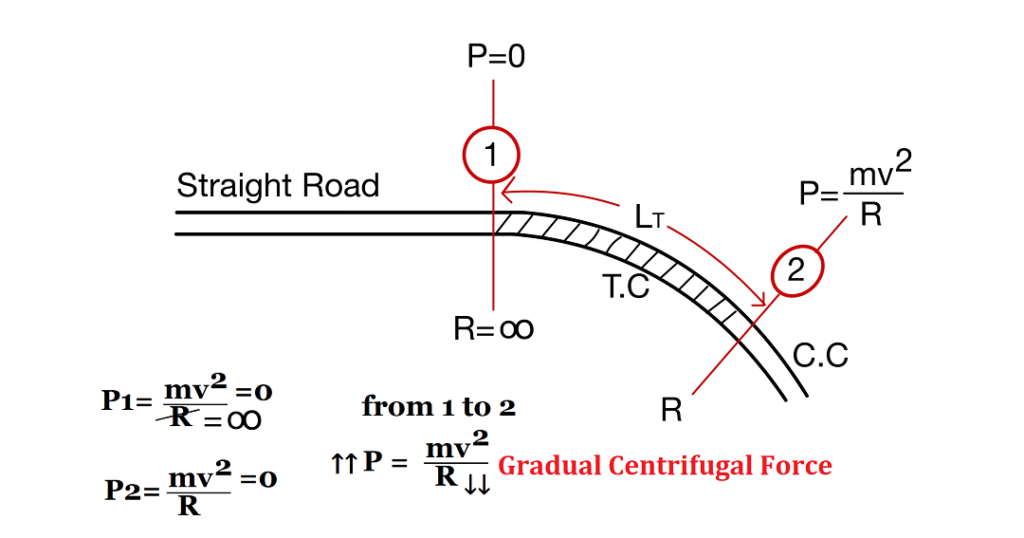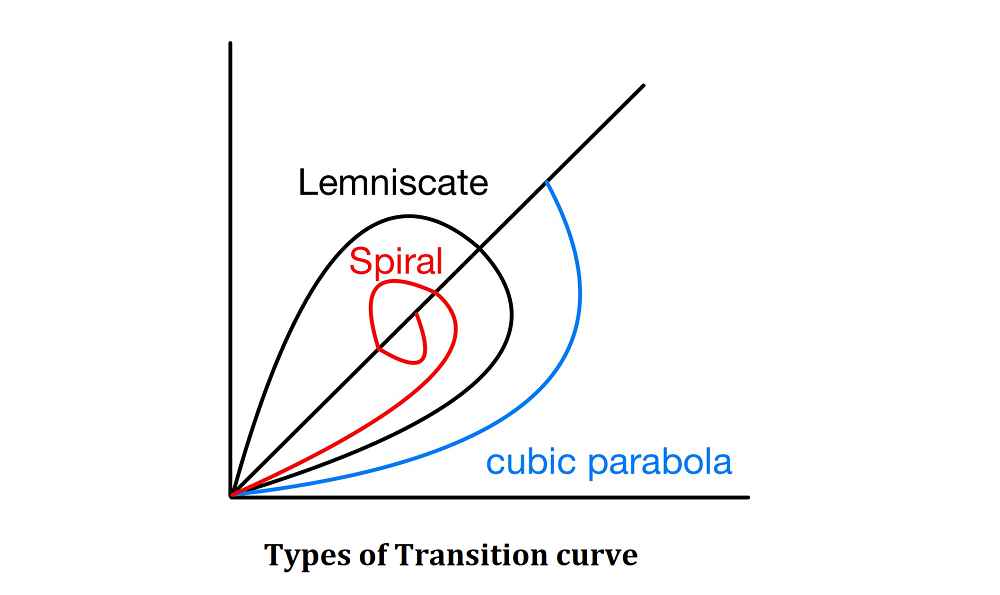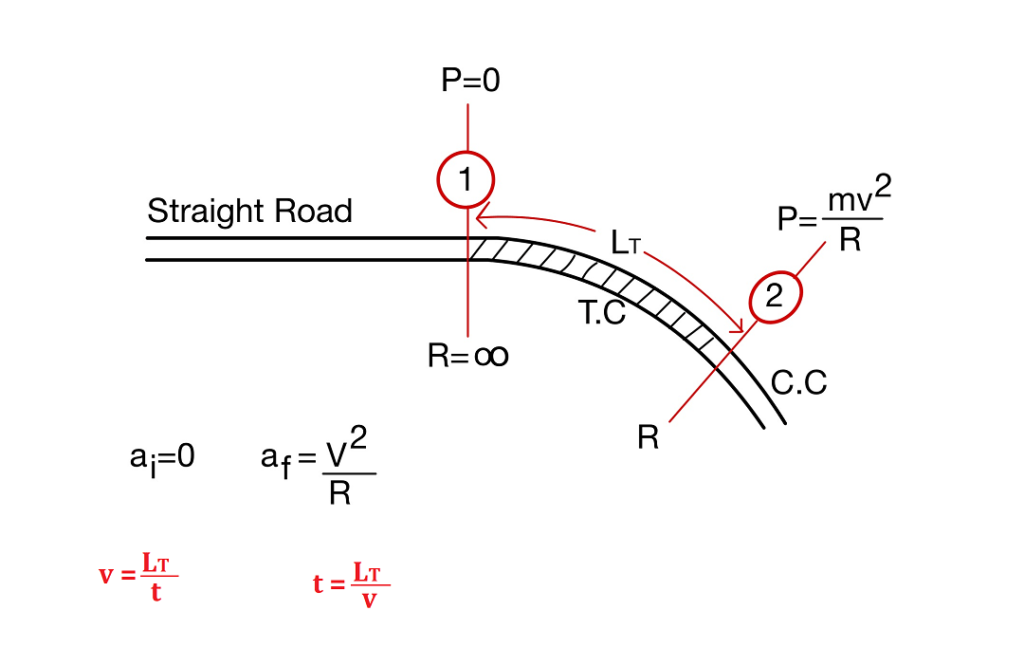Transition Curves:
When a vehicle traveling on a straight road enters into a horizontal curve instantaneously, it will ca discomfort to the driver. To avoid this, it is required to provide a transition curve. This may be provided either between a tangent and a circular curve or between two branches of a compound or reverse curve.
Transition curve has a radius equal to infinite when it meets to straight Road within gradually change to designate radius towards the circular curve.
Note: This topic is part of the second chapter of Highway Engineering. I suggest reading this topic in the context of the complete chapter: Geometric Design of Highway. If you want to read the entire Highway Engineering, click here: Highway Engineering.

The objectives of providing a transition curves are:
- To gradually introduce the centrifugal force between straight and circular curves.
- To avoid the certain jerk.
- To gradual introduction of superelevation and extra widening.
- To enable the driver turn the sheering gradually for comfort and security.
- To improve aesthetic appearance.
A transition curve should salisty the following conditions
- It should meet the straight path tangentially.
- It should meet the circular curve tangentially.
- It should have the same radius as that of the circular curve at its junction with the circular curve.
- The rate of increase of curvature and superelevation should be the same.
The length of transition curve required on a horizontal highway curve depends upon the following factors:
- Radius of circular curve, R
- Design speed, V
- Allowable rate of change of centrifugal acceleration, C
- Maximum amount of super elevation, E which depends on the maximum rate of superelevation, e and the total width of the pavement, B at the horizontal curve.
- Rotation of pavement cross-section either about the inner edge or the centre line
Different Types of Transition Curves
The types of transition curves commonly adopted in horizontal alignment of highways are:
1.Spiral
2.Bernoulli’s Lemniscate
3.Cubic Parabola

NOTE:
- In all these curve the radius decreases at length increases.
- But the rate of change of radius or rate of change of centrifugal force is not constant in case of Lemniscate and cubic parabola.
- Hence a spiral curve is used as transition curve as it fulfills the requirement of ideal transition curve.
- According to IRC an ideal transition curve is spiral because rate of change of radial acceleration (C) remains constant.
Length of Transition Curve
The length of transition curve is designed to fulfill three conditions:
- Rate of change of centrifugal acceleration to be developed gradually
- Rate of introduction of the designed superelevation to be at a reasonable rate, and
- Minimum length by IRC empirical formula
The length of transition curve following three conditions:
Length of Transition Curve by the Rate of Change of Radial Acceleration
Length of Transition Curve is designed such that the rate of change of centrifugal force is low.
Rate of change of centrifugal acceleration:

v=Velocity of the vehicle in m/s | R= Radius of the curve in m |
C= rate of change of radial acceleration in m/sec3 | LT= Length of Transition Curve in m |
t= time taken by vehicle in second to travel the transition length at speed v. | |
| \(L_T=\frac{v^{3}}{C·R}\) | (Here,v in m/s) |
or | |
\(L_T=\frac{0.0215V^{3}}{C·R}\) | (Here,V in km/s) |
The rate of change of centrifugal acceleration is given by an empirical formula recommended by IRC
Subject to a maximum of 0.8 and minimum of 0.5.
Length of Transition Curve by Rate of Change of Superelevation
Rate of introduction if superelevation = 1V in NH
1= elevation provided
N= Length of Transition curve
Rate As per IRC
| 1:150 For Plain and Rolling terrain | 1:100 For Urban /Built Up Area | 1:60 For Hilly Area |
The length of transition curve = N·x
where x is elevation of outer edge.
(i) When pavement is rotated about inner edge

LT=eN(W+WE)
W=Width of pavement
WE= Extra widening
(ii) When pavement is rotated about centre

LT=\(\frac{1}{2}\)eN(W+WE)
Empirical Formula for the Length of Transition Curve Recommended by IRC
Setting Out of Transition Curve
When a Transition curve is introduced between a straight and circular curve, then circular curve has to be shifted so that the transition curve meets the circular curve tangentially. The shifted (S) of a circular curve is given by
For Detailed Analysis of Highway Engineering Step By Step.
Thank you for explaining in a right way easy and simple
अच्छा प्रयास किया है, पर इनर एज आउटर एज को समझाना था, मुझे मालूम है एज क्या है मगर नहीं मालूम होता तो confusion rh जाता,
That’s a really nice content, just sufficient and effective, you guys are providing…
Thank you for this..
Nice , precise & informative article.